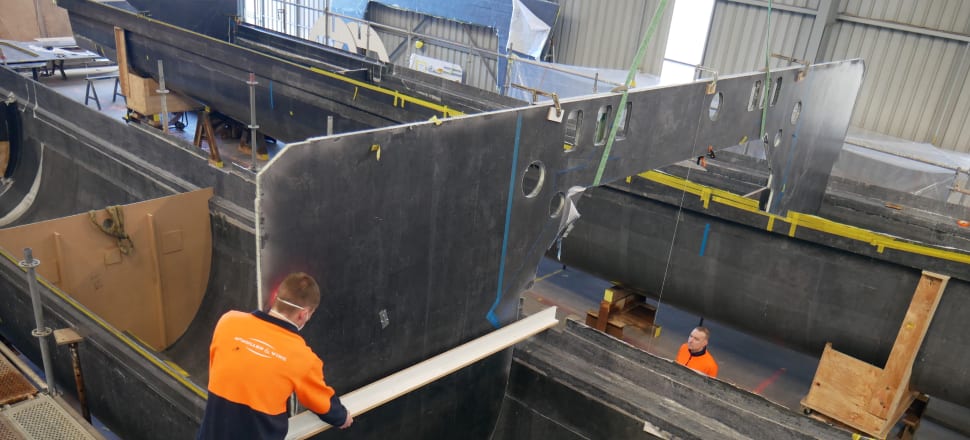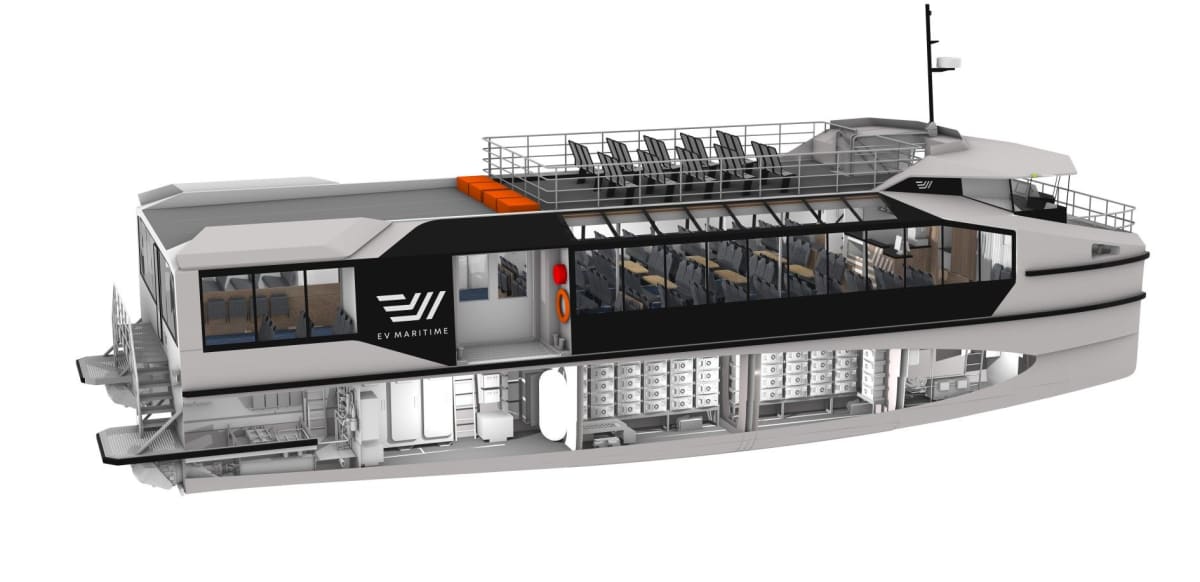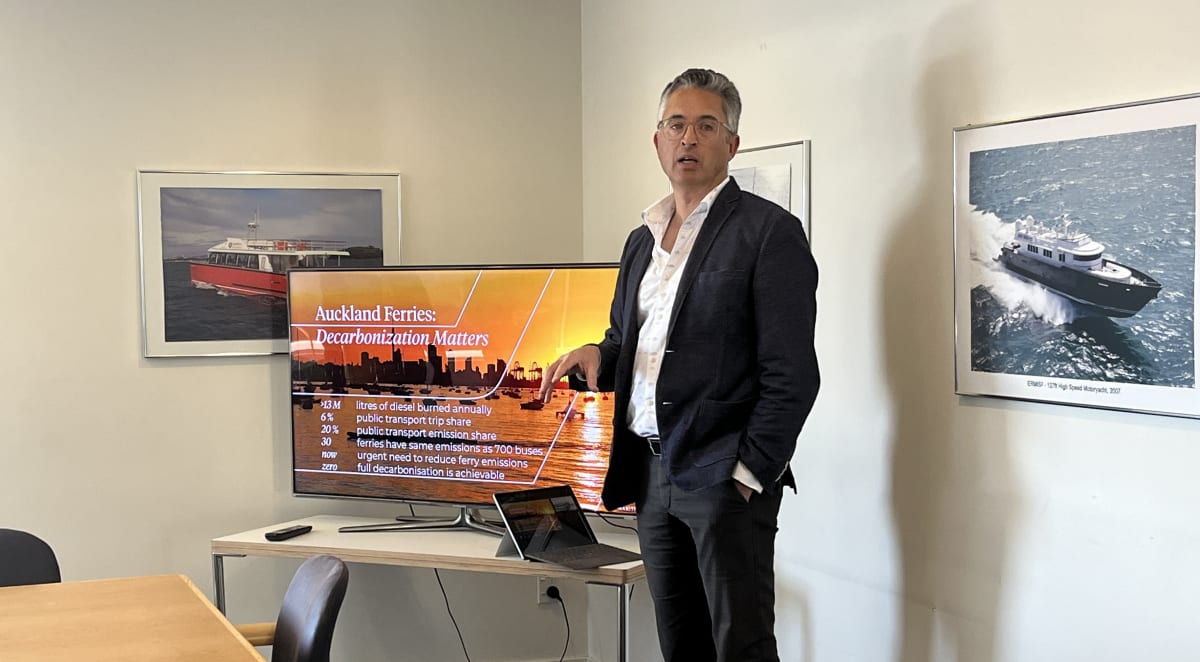
The electrification of Auckland’s ferry fleet stands to massively reduce emissions, but the immense time and capital requirements mean it's no quick fix
In a cavernous warehouse on the shores of the Tāmaki estuary, the skeletons of two enormous catamarans are taking shape.
Four carbon fibre hulls lie like newfangled waka at boat-builders McMullen & Wing in Mt Wellington, as workers push to get the vessels seaworthy for some time towards the end of next year.
READ MORE:
* Electric ferries the winner in Auckland's budget
* Auckland Transport wants to regain the city's trust
The two boats are the first of their kind for Auckland – electric battery ferries that will begin shuttling commuters around the harbour sans carbon emissions in 2025.
The two 200-passenger vessels will join two 300-passenger hybrid electric vessels under construction in Whanganui in a staged replacement of the current fleet over the next 10 years.

But while it’s a move that would eventually see around 13 million fewer litres of diesel burned each year, that 10-year plan is a long and costly process.
The Crown pitched in $27 million last year to pay for the near $40m construction of the two yet-to-be-named ships.
They are likely to go into service first of all within reach of the city centre, running on routes to Devonport, Hobsonville Point and Half Moon Bay, some of which will also be kitted out with charging infrastructure.
That will be a reality within the next two years.
But high costs of construction, revenue uncertainty at Auckland Transport and an unclear trajectory of technological progress all contribute to a murkier timeframe for ports further afield.
Routes like Gulf Harbour, Pine Harbour and Waiheke Island already have their own share of uncertainties to deal with.
Price changes on Fullers-operated services have seen Waiheke residents protest, while training requirements will soon see connections to the Whangaparāoa Peninsula reduced for the next 18 months.
Electrification will pose no quick solutions for these vulnerable transport connections, however.
Auckland Transport programme director Nathan Cammock said the electric ferries would be put to use in the inner and mid-harbour areas first, as a trip to Gulf Harbour would require the vessel to charge for 20 to 25 minutes.
“The initial business case and plan is for us to knock off those inner-harbour and mid-harbour routes, and that will buy us time for battery technology to catch up."
He said distant ports might be served in future by hydrogen or methanol fuel cell-powered vessels.
“There’s all these things we still need to weigh up, really.”
But while uncertainties still surround the details of total fleet replacement, more central ferry lines are closer than ever to cutting emissions.
It’s an area where a little can go a long way. Ferries carry just 6 percent of public transport users, yet generate a fifth of all public transport emissions. Auckland’s current fleet of 27 diesel ferries the emissions of around 700 buses – roughly half of the city’s bus fleet.
Michael Eaglen, CEO of ship builders and project partners EV Maritime, said the economic benefits were highest in electrifying the four mid-harbour routes: West Harbour, Hobsonville Point, Birkenhead and Half Moon Bay.
Ferries would only need to charge for four to 10 minutes at after each of these routes, and Eaglen suggested the ship could be plugged in and charged during the unloading and loading of passengers.
“First thing you do is tie the lines on, second thing you do is plug in,” he said.

But while the 20-minute charging time up at Gulf Harbour could pose a problem, Eaglen said the ships had been designed with standardisation in mind, meaning they could be used for the longer routes.
“What we did is we designed boats that are going to be capable of operating on the Gulf Harbour route, and capable of doing that in a wider weather window than is currently operating,” he said. “These are quite narrow hulls, so they slice through the water more than going over it. And the cross deck clearance is quite high, so that means the waves don’t impact on the underwing.”
It means less turbulence on choppy Auckland seas.
Ferry services cut due to wild weather generally have more to do with concerns about passenger comfort than safety, so it's expected the relatively smooth experience aboard the new catamarans will increase the threshold for cancellation.
But while the boats are still on dry land, Auckland’s ferry network is groaning under the twin pressures of high off-peak usage and a shortage of skippers.
Auckland Transport’s Stacey van der Putten last week told the council’s transport and infrastructure committee routes were being impacted due to a lack of skippers, who each take four to seven years to train and require hands-on supervision by experienced staff.
"There is no absence of new people entering the industry, but the gap right now is those well-experienced skippers that can be deployed, seven to 10 years' experience is what they are looking for,” she said.
Staffing levels are 88 percent of what’s required, with a shortfall of around 25 skippers and deckhands needed to return service to pre-pandemic levels.
Meanwhile, patronage is at 130 percent of what it was in 2019.
People are turning to ferries in a big way, but not just to get to work. Off-peak and weekend times have increased in proportion, with rush hours quieter in this era of working from home.
The electric ferries will begin taking passengers some time in 2025, but this peak is happening right now.
Auckland Transport will be hoping the appetite for maritime public transport will be sustained as the ships near completion.

The transport agency has ferry crew recruitment, wage increases and a public notification of a ferry disruption plan on the books for next year.
The year after, that new ferry smell might just lure commuters out onto the water.
Eaglen said the 24 interior spaces for bicycles could add to the allure when compared to current exterior stern storage – especially as the value of some commuters' bikes skyrocket with developing technology.
“Nobody wants to put an e-bike on the back of a ferry and have it wafted with salt water all the time,” he said.
A new standardised design across the electrified fleet would prioritise accessibility and make ferry travel attractive.
But new design wasn’t just needed for the interior of the ships. The hulls are made of expensive folded carbon fibre, a substance light enough to make batteries cost-effective and hardy enough to effectively double the lifespan of the vessels.
“It makes electric viable – as you can have smaller motors and smaller batteries,” Eaglen said.
It’s perhaps the expensive materials used in the design that also means new additions to the fleet are still an unknown – this is no wooden raft or rubber dinghy.
As Eaglen put it: “This is not yesterday’s ferry”.
It appears it’s not tomorrow’s either – nor next year’s. It’s 2025 that will be the year of the electric ferry in the city of sails.







